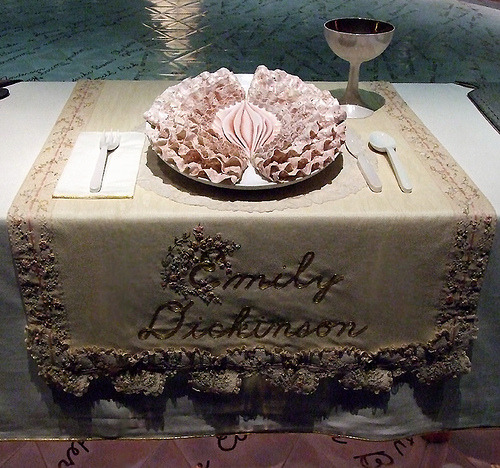I do believe that teaching elementary children to be conscious about gender as well as other topics of diversity is important. However, The Dinner Party displays images of female reproductive organs, so how do you work with that in an elementary school. I could see this artwork as less controversial for students who have gone through health classes and have been taught about the human anatomy, because they are at an age where they can responsibly interpret the information. I am not saying that kindergarten age children do not know about their reproductive organs, but discussing vulvar forms and the metaphors behind them in an elementary setting could lead to discussions on reproduction that many people might deem as inappropriate. Parents of the children could feel that it is not the elementary art teacher's place to be teaching their children about the birds and the bees, if a question were to arise.
I do recall examples of elementary teachers who used The Dinner Party. I would be curious to know in more depth as to how the teachers in elementary schools used the content of the piece, if any situations arose, and how they handled them, because as a future art educator I would like to be as well informed and prepared as possible when it comes to topics of controversy, because it is a common subject in art.
Judy Chicago (American, b. 1939). The Dinner Party (Emily Dickinson place setting), 1974–79. Mixed media: ceramic, porcelain, textile. Brooklyn Museum, Gift of the Elizabeth A. Sackler Foundation, 2002.10. © Judy Chicago. Photograph by Jook Leung Photography
Reference
Nordlund, C., Speirs, P., & Stewart, M. (2010). An invitation to social change: Fifteen principles for teaching art. Art Education, 63(5), 36.

In regards to your question about exposing students to imagery in the art classroom that is referencing the female genitalia, I think it is all how the lesson is structured. By screening the images the students are exposed to beforehand, the plates where the female reproductive organs are prevalent can be tossed out. Students can still talk about the issue of gender and the ideas behind the piece because those topics are appropriate for their age group. Addressing how women of history are often overlooked can be done without showing students every single place setting especially if one could be controversial. Like discussed in class it is best to also send some type of notification home with the students beforehand. Giving parents a list of the images that are going to be used in class, along with an explanation of the project upfront, will allow for discussions with upset parents to be handled preemptively when emotions are not as severe. Also informing the principal of the project will allow him or her to better handle the situation if problems do arise. It is important for students of all ages to be exposed to these types of ideas however, exposure to all of the imagery is not necessary in the process of promoting discussion about contemporary issues in the world and their relevance to artists’ works. Art educators need to realize that the classroom is different from the gallery. Things that are appropriate in one setting may not be in the other. The idea of art education is to further the knowledge of students not cause conflict with parents. By being proactive issues can be addressed and angry parents can be properly informed and given the opportunity to offer or not offer their consent.
ReplyDeleteKatie, I agree with you for the most part, but I would urge you to think more about the distinction you make between the classroom and the gallery. While I think many people agree that a gallery and a classroom are often very different learning environments, I would ask: does this dichotomy need to continue? Is it possible for art educators to help bridge these two learning environments in ways that are not only meaningful to our students, but also to administrators, parents, and community members? In other words, how can what we do in and out of the classroom shift the preconceived notions of where learning happens and how learning should happen? Art educators can question, analyze, and challenge notions of what is appropriate curriculum and pedagogy in various learning settings in pursuit of this line of questioning. While such questioning may require all parties involved to enter uncharted learning territory, it can provide worthwhile opportunities for intellectual growth.
Delete